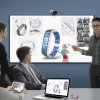With the explosion of wearable technology and legislation like the Affordable Care Act, the medical product industry is rapidly evolving. Healthcare is seeing unprecedented changes, creating new opportunities for devices that connect consumers and doctors to information faster, easier, and more efficiently.
"It's coming to a point where there are just amazing breakthroughs every day," says Tor Alden, Principal and CEO at HS Design (HSD), where he has been directly involved in medical design for over 14 years. "[Technologists] are innovating and changing the landscape of how healthcare is going to be done to the point where we're not going to recognize it in the next three or four years from where it is now." It's a changing landscape that has caught the eye of many innovative startups, who now make up half of HSD's client list. "These new products have amazing technology, but it needs to be humanized and centered on user needs to be successful." HSD is positioning itself to be a bridge connecting the medical and healthcare startups with the investment banker communities. Alden predicts that if the growth continues at this rate, that number could be closer to 80% in the next few years.
One of the factors opening the door for innovation in the medical device industry is the Affordable Care Act. As requirements roll out for health care providers, there is an increasing need for new tools and products that ensure patient compliance. Take a typical hip replacement, for example: Under the Affordable Care Act, if a doctor or hospital is not tracking the compliance and rehabilitation of that patient and they return within a year with no improvement, the hospital owes money to the government. There's a financial incentive to make sure patients get better and, therefore, to track and evaluate their progress. This could spur invention around hip replacements—possibly leading to one with a chip (i.e., embedded UDI) to track rehabilitation or remind patients to get complete their physical therapy exercises.
"The Affordable Care Act is a great opportunity for the design community right now. Everybody is trying to figure out how to innovate increase patient compliance and allow caregivers tools to manage the healthcare services," says Alden. "Between that and the iHealth generation of iPhones, smartphones, iPads, and everybody wanting to have more control over their healthcare knowledge, there's a huge opportunity for new products."
In the century of the wearable device, nearly everyone has some type of personal fitness tracker. For the medical device industry, this means a rise in connected health as consumers clamor to track everything from their steps to calories to sleep cycles. With that surge in technology comes an accelerated need for the design and development of interfaces between the technology and the consumer. "This is the most interesting space that a designer could work today. It's fascinating," shares Aidan Petrie, Co-Founder and Chief Innovation Officer of Ximedica, a medical product development company headquartered in Rhode Island. "We work between humans and the products they use and make sure that they are more usable, satisfactory and safer."
Despite the incentive for new and better products, the medical device industry remains a difficult niche to break into, due to FDA regulations, enormous amounts of capital required, the need for a high level of specialization, and timelines that span 2–6 years. All these factors contribute to a high failure rate, causing many of these projects to be cancelled before they even reach the prototype stage.
Dassault Systèmes is trying to lower that rate of failure by creating software applications that help these companies better understand and anticipate these challenges from the beginning of a project. The software company released an all-in-one program called Ideation & Concept Design for Medical Device industry solution experience, a cloud-based platform designed specifically to take a team through the entire product development process. From initial ideation and market research to verification and validation, the system tracks deliverables and traceable requirements demanded of the strict FDA and other regulations around this sector. With Ideation & Concept Design for Medical Device, Dassault Systèmes shortens the amount of time it takes to bring a product to market, which is critical in a quickly expanding market where there is no time to waste.
"The medical device industry will explode for the next twenty years. It will be the place to be focused as a designer," says Petrie. "It's great doing things that change people's lives, and a product can still look beautiful at the same time."
source:Core77
Designing For The Medical Device Industry:the Future-connected Health

